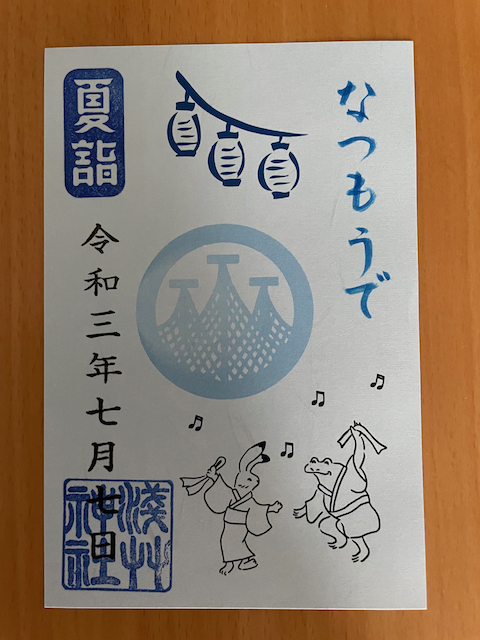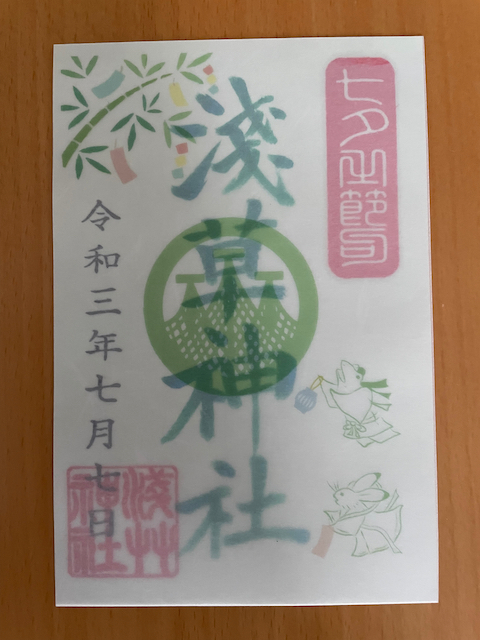Asakusa Jinja has special goshuin for its natsumoude, shown in the photographs.

The blue one is the natsumoude goshuin, so you can get it with any date from the 1st to the 7th; the date is always the date on which you visited the jinja. You could get seven, one for every day, and I suspect that some people did. The rabbit and frog are based on the Chōjūgiga, which always sounds like a data communication standard to me, but is actually a set of scrolls, dating from the twelfth century, showing amusing animals doing human things. (In English, it is apparently called the Scrolls of Frolicking Animals.)
One notable thing about this goshuin is that there is no red on it. The “shu” refers to the traditional red colour of the seal impression, so the meaning is clearly shifting a bit with changes in practice at jinja.

The green one is the tanabata goshuin, which was only available on the seventh. (It actually has some red on it!) Since I happened to be volunteering there that day, I got both.
Traditionally, goshuin were stamped directly into your goshuinchō, or goshuin book, but during the pandemic a lot of jinja have been giving them out on paper like this. There are two benefits. First, the jinja staff do not have to handle the book, which reduces the risk of transmission that way. Second, people do not have to wait around to get their book back, which reduces crowding.
That is important. When I arrived to start volunteering, before 10 am, there was a short queue, and by the time we had finished setting up, at about half past, there were a couple of dozen people lined up to get the goshuin. That queue did not really get much shorter for the whole day. Indeed, at the end of the day a young woman asked us if she could still get a goshuin, because the website had said that they were being offered until 3 pm, but there was still a queue. (I said we didn’t know, but that she should ask the chief priest, who was standing near our booth. She did get her goshuin, and she stopped at the booth to let us know on her way out.)
Goshuin are particularly popular with women in their twenties and thirties, it seems, and in fact the jinja has a rule of only one of each goshuin per person, because otherwise they get resold online at a profit. As they are supposed to be a record of one’s visit to the jinja, that is a definite no-no.
Most jinja require an offering of ¥300 or ¥500 for a goshuin (¥500 at Asakusa Jinja), so they make good souvenirs if you are planning to visit several jinja while in Japan. They are, however, not appropriate as gifts.
I am an avid collector of goshuin, but I have never thought of buying one online. For me, that contradicts the whole idea of the goshuin! By the way, it would be great if you could offer more background on the “goshuin-business”, as there are a few jinja who churn out new goshuin every few days, not limited to a festival (like the one you mention at Asakusa Jinja) but just so. Is that for income only?
I know, right? What is the point of getting them online?
I don’t know enough about the background to say anything definite about the “goshuin business”. I strongly suspect that it is mostly about income, and about getting enough to make the jinja viable. On the other hand, encouraging people to visit the jinja frequently, and pay their respects, is a central part of Shinto, so it is not without religious justification. I suspect that this is why I haven’t seen much comment about it from Jinja Honchō: it looks like a way to support a jinja that does not violate any religious principles.
Thanks a lot for your answer. I am happy to support a jinja by getting a goshuin, or several if they offer them. I also noticed that some of the larger jinja have a very simple goshuin, while those who offer more “artistic” goshuin are often smaller jinja who may need the goshuin-business for income. But I also noticed that writing down the simple goshuin does not take much time, so that may also reflect the larger number of visitors at larger jinja.
By the way, I looked through my goshuin collection, and I have two goshuin without any red colour, one from Karasumori Jinja in Tokyo and one from Miwa Jinja in Nagoya; both are summer-special goshuin.
Interesting. Maybe there’s something about summer.
I am in agreement with you about supporting jinja in this way. Most people collecting goshuin do seem to take on board the idea that they should pay their respects to the kami first, so I think it has the potential to be very good for jinja.
Pingback: Natsumoude at Asakusa Jinja – Mimusubi